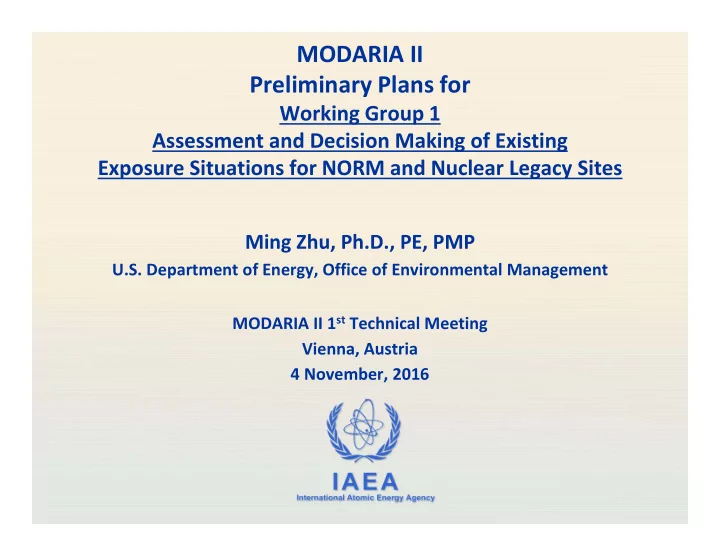

MODARIA II Preliminary Plans for Working Group 1 Assessment and Decision Making of Existing Exposure Situations for NORM and Nuclear Legacy Sites Ming Zhu, Ph.D., PE, PMP U.S. Department of Energy, Office of Environmental Management MODARIA II 1 st Technical Meeting Vienna, Austria 4 November, 2016 IAEA International Atomic Energy Agency
Participants • • Talal Almahayni Belgium Daria Koliabina Ukraine • • Amanda Anderson U.S.A. Branko Kontic Slovenia • • Rodolfo Avila Sweden Matthew Kozak U.S.A. • • Karine Beaugelin ‐ Seiller France Nana ‐ Owesua Kwamena Canada • Yunxuan Liao China • Werdi Putra Daeng Beta Indonesia • Anca Melintescu Romania • Nick Beresford U.K. • Stephane Pepin Belgium • Geert Biermrns Belgium • Adrian Punt U.K. • Weiya Cheng China • Borut Smodis Slovenia • David Copplestone U.K. • Valentin Terziev Bulgaria • Eduardo Figueira da Silva Brazil • Leena Torpo Finland • Stacey Fernandes Canada • Russell Walke U.K. • Dan Galeriu Romania • Jeff Whicker U.S.A. • Violeta Hansen Denmark • Mike Wood U.K. • Diederik Jacques Belgium • Tamara Yankovich IAEA • Mathew Johansen Australia • Charley Yu U.S.A. IAEA • Ming Zhu U.S.A.
Proposed Objectives of this Working Group • To further develop radionuclide transport and exposure models, as well as radiological impact assessment approaches, to support decision making for the remediation of NORM and legacy sites. • To conduct model comparisons using monitoring data, where available. • To further develop methodologies and toolsets for conducting decision analyses that aid in decision making. IAEA
Problem Definition • Existing exposure scenarios of NORM and legacy waste sites IAEA
Proposed Tasks – Risk Assessment • Develop improved methodologies for radiological impact assessments • Improve assessment models • Conduct model–model and model–data comparisons • Apply methodologies to existing sites and facilities • Train end users (regulators, operators, other stakeholders) on use of NORMALYSA, RESRAD, and other codes IAEA
Proposed Tasks – Risk Assessment • Develop improved methodologies for radiological impact assessments FEP screening (Expand the FEP List for NORM/legacy sites?) • Improve assessment models Source terms NORMALYSA, RESRAD, others • Conduct model–model and model–data comparisons NORMALYSA, RESRAD, PRG, ERICA, others Model ‐ data comparison for selected sites • Apply methodologies to existing sites and facilities 4 ‐ 5 selected sites • Visualization of spatial radionuclide distributions at the Andreeva Bay SNF temporary storage facility in Russia To be confirmed • Train end users (regulators, operators, other stakeholders) on use of codes when they attend MODARIA meetings or through TC NORMALYSA, RESRAD, and others IAEA
Tessenderlo Site, Belgium Processing of phosphate ore for the production of dicalciumphosphate (contamination with Radium) IAEA
Pridneprovsky Uranium Legacy Site, Ukraine Legacy site with tailings and contaminated buildings A E A C B D B IAEA
Material Disposal Area B ‐ Los Alamos National Laboratory, USA • Operated from ~1943 ‐ 1948 • Unknown amount of Pu ‐ 239 waste in shallow burial pits • Goal ‐ remediate and release property to public IAEA
Pocos de Caldas U mining and processing facility, Brazil Flooded Mine Pit at former U Mine Waste rock piles at former U Mine IAEA
Proposed Tasks – Decision Analyses • Develop lists of “prevailing circumstances” and site specific situations • Develop methodologies and toolsets for formalized decision analysis IAEA
Proposed Tasks – Decision Analyses • Document decision making process for lessons learned MDA ‐ B land transfer after completion of cleanup at the LANL site, USA Closure of mine Zirovski vrh, Slovenia Beaverlodge, Canada Chernobyl site, Ukraine? • Develop lists of “prevailing circumstances” and site specific situations Review non ‐ nuclear (mining, chemical, oil/gas, construction) best practices List contributing factors that cannot be modelled easily, but need to be considered in decision making • Develop methodologies and toolsets for formalized decision analysis Consider application of the DA methodologies to case studies Define end ‐ state and optimize monitoring program using high ‐ performance computing codes Develop structured decision making framework with participation of interested parties IAEA
Collaborations/Leveraging • Internal cooperation within the MODARIA II project ➢ WG 2: Collaboration on remedy selections; Attend each WG’s IMs; joint meeting at next TM ➢ WG 5: Members to join the team in running the biota models ➢ WG 6: Near surface systems; FEPs list • Internal within the IAEA ➢ IAEA TC Chernobyl Remediation Group ➢ ICRP Committee 5 • External ➢ ASCM & CBP Projects ➢ P&RA CoP IAEA
Proposed Interim Meeting 26 ‐ 30 June, 2017 FANC & SCK ‐ CEN Brussels, Belgium IAEA
Recommend
More recommend